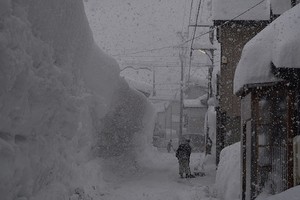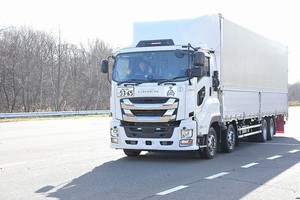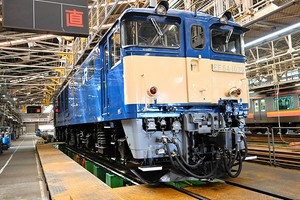THE ASSOCIATED PRESS
January 15, 2024 at 11:30 JST
 A TV screen shows a file image of North Korea's missile launch during a news program at the Seoul Railway Station in Seoul, South Korea, Jan. 14, 2024. (AP Photo)
A TV screen shows a file image of North Korea's missile launch during a news program at the Seoul Railway Station in Seoul, South Korea, Jan. 14, 2024. (AP Photo)
SEOUL--North Korea on Monday said it flight-tested a new solid-fuel intermediate-range missile tipped with a hypersonic warhead as it pursues more powerful, harder-to-detect weapons designed to strike remote U.S. targets in the region.
The report by North Korea’s state media came a day after the South Korean and Japanese militaries detected the launch from a site near the North Korean capital of Pyongyang, in the North’s first ballistic test of 2024.
The launch came two months after North Korea said it successfully tested engines for a new solid-fuel intermediate-range missile, which reflected a push to advance its lineup of weapons targeting U.S. military bases in Guam and Japan.
The North’s official Korean Central News Agency said Sunday’s launch was aimed at verifying the reliability of the missile’s solid-fuel engines and the maneuverable flight capabilities of the hypersonic warhead. It described the test as a success.
KCNA did not mention whether North Korean leader Kim Jong Un was present at the test, which it said was part of the country’s regular weapons development activities.
“The test-fire never affected the security of any neighboring country and had nothing to do with the regional situation,” KCNA said.
South Korea’s Joint Chiefs of Staff said the missile flew about 1,000 kilometers (620 miles) before landing in the waters between the Korean Peninsula and Japan. The North’s existing intermediate-range missiles, including the Hwasong-12 that may be able to reach the U.S. Pacific territory of Guam, are powered by liquid-fuel engines, which need to be fueled before launch and cannot stay fueled for long periods of time.
Missiles with built-in solid propellants can be made ready to launch faster and are easier to move and conceal, which theoretically makes it harder for adversaries to detect and preempt the launch in advance.
The North since 2021 has also been testing hypersonic weapons, which are designed to fly at speeds in excess of Mach 5, or five times the speed of sound. If perfected, such systems could potentially pose a challenge to regional missile defense systems because of their speed and maneuverability.
Hypersonic weapons were part of a wish-list of sophisticated military assets Kim unveiled in 2021, along with multi-warhead missiles, spy satellites, solid-fuel long-range missiles and submarine-launched nuclear missiles.
The North last year tested a solid-fuel intercontinental ballistic missile for the first time, which added to its arsenal of weapons targeting the U.S. mainland, and also launched its first military reconnaissance satellite in November.
Tensions on the Korean Peninsula are at their highest point in years after Kim in recent months ramped up his weapons demonstrations. The United States and its allies Seoul and Tokyo responded by strengthening their combined military exercises and sharpening their nuclear deterrence strategies.
There are also concerns about an alleged arms cooperation between North Korea and Russia as they align in the face of separate, intensifying confrontations with Washington. In their latest sign of diplomacy, a North Korean delegation led by Kim’s foreign minister, Choe Sun Hui, left Pyongyang on Sunday for a visit to Russia at the invitation of Russian Foreign Minister Sergey Lavrov, KCNA said. The report did not specify what would be discussed.
The U.S. and South Korean governments have claimed that North Korea has been providing Russia with arms supplies, including artillery and missiles, to help prolong its invasion of Ukraine.
The Biden administration said it has evidence that missiles provided by North Korea to Russia had been used in the war in Ukraine. In a joint statement last week, the U.S., South Korea and their partners said the missile transfer supports Russia’s war of aggression and provides North Korea with valuable technical and military insights.
Some experts say that the North could try to further dial up pressure in an election year in South Korea and the United States.
North Korea earlier this month fired a barrage of artillery shells near the disputed western sea boundary with South Korea, prompting the South to conduct similar firing exercises in the area. Kim has also released verbal threats, using a political conference last week to define South Korea as the North’s “principal enemy” and threatened to annihilate it if provoked.
Experts say Kim likely wants to see South Korean liberals win a crucial parliamentary election in April to deal a blow to conservative President Yoon Suk Yeol, who has taken a hard line on the North. They say Kim may also want former U.S. President Donald Trump to be elected again, possibly thinking that would give him an easier shot at winning U.S. concessions over the nuclear standoff.
Trump met Kim three times during his term, but their diplomacy never recovered from the collapse of their second meeting in 2019, when the Americans rejected North Korea’s demand for major sanctions relief in exchange for a partial surrender of its nuclear capabilities.




















A peek through the music industry’s curtain at the producers who harnessed social media to help their idols go global.
A series based on diplomatic documents declassified by Japan’s Foreign Ministry
Here is a collection of first-hand accounts by “hibakusha” atomic bomb survivors.
Cooking experts, chefs and others involved in the field of food introduce their special recipes intertwined with their paths in life.
A series about Japanese-Americans and their memories of World War II